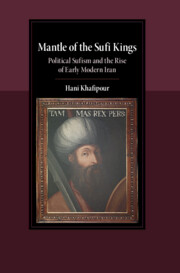Refine search
Actions for selected content:
616368 results in History
Chapter 2 - Expansive Languages in Nineteenth-Century Central Africa
- from Part I - Producing Print
-
-
- Book:
- African Literature in Transition
- Published online:
- 23 October 2025
- Print publication:
- 06 November 2025, pp 59-76
-
- Chapter
- Export citation
Part I - Producing Print
-
- Book:
- African Literature in Transition
- Published online:
- 23 October 2025
- Print publication:
- 06 November 2025, pp 13-146
-
- Chapter
- Export citation

Mantle of the Sufi Kings
- Political Sufism and the Rise of Early Modern Iran
- Coming soon
-
- Expected online publication date:
- November 2025
- Print publication:
- 06 November 2025
-
- Book
- Export citation
Part II - Readers and Audiences
-
- Book:
- African Literature in Transition
- Published online:
- 23 October 2025
- Print publication:
- 06 November 2025, pp 147-218
-
- Chapter
- Export citation
Chapter 5 - A Tale of Two Print Cultures
- from Part I - Producing Print
-
-
- Book:
- African Literature in Transition
- Published online:
- 23 October 2025
- Print publication:
- 06 November 2025, pp 112-128
-
- Chapter
- Export citation
Tables
-
- Book:
- From Frontiers to Borders
- Published online:
- 23 October 2025
- Print publication:
- 06 November 2025, pp ix-x
-
- Chapter
- Export citation
Index
-
- Book:
- The Rise and Fall of Turkey's Democrat Party
- Published online:
- 23 October 2025
- Print publication:
- 06 November 2025, pp 300-305
-
- Chapter
- Export citation
Conclusion
-
- Book:
- The Rise and Fall of Turkey's Democrat Party
- Published online:
- 23 October 2025
- Print publication:
- 06 November 2025, pp 268-275
-
- Chapter
- Export citation
6 - The Paris Peace Conference
-
- Book:
- From Frontiers to Borders
- Published online:
- 23 October 2025
- Print publication:
- 06 November 2025, pp 186-216
-
- Chapter
- Export citation
Bibliography
-
- Book:
- The Rise and Fall of Turkey's Democrat Party
- Published online:
- 23 October 2025
- Print publication:
- 06 November 2025, pp 276-299
-
- Chapter
- Export citation
Abbreviations
-
- Book:
- Institutional Change and Property Rights before the Industrial Revolution
- Published online:
- 23 October 2025
- Print publication:
- 06 November 2025, pp xi-xii
-
- Chapter
- Export citation
5 - The Origins of Boundary Studies
-
- Book:
- From Frontiers to Borders
- Published online:
- 23 October 2025
- Print publication:
- 06 November 2025, pp 144-185
-
- Chapter
- Export citation
Dedication
-
- Book:
- The Rise and Fall of Turkey's Democrat Party
- Published online:
- 23 October 2025
- Print publication:
- 06 November 2025, pp v-vi
-
- Chapter
- Export citation
4 - 1952
-
- Book:
- In the Shadow of the Vatican
- Published online:
- 23 October 2025
- Print publication:
- 06 November 2025, pp 123-160
-
- Chapter
- Export citation
Contents
-
- Book:
- From Frontiers to Borders
- Published online:
- 23 October 2025
- Print publication:
- 06 November 2025, pp vii-vii
-
- Chapter
- Export citation
Tables
-
- Book:
- African Literature in Transition
- Published online:
- 23 October 2025
- Print publication:
- 06 November 2025, pp x-x
-
- Chapter
- Export citation
Welcome
-
- Journal:
- Transactions of the Royal Historical Society / Volume 3 / December 2025
- Published online by Cambridge University Press:
- 06 November 2025, pp. 1-2
- Print publication:
- December 2025
-
- Article
-
- You have access
- Open access
- HTML
- Export citation
Preface
-
- Book:
- Institutional Change and Property Rights before the Industrial Revolution
- Published online:
- 23 October 2025
- Print publication:
- 06 November 2025, pp ix-x
-
- Chapter
- Export citation
From Bible to Law in the Early Middle Ages. Adaptations of the Old Testament in the Collectio Hibernensis and King Alfred’s Law-Book
-
- Journal:
- The Journal of Ecclesiastical History , First View
- Published online by Cambridge University Press:
- 06 November 2025, pp. 1-24
-
- Article
-
- You have access
- Open access
- HTML
- Export citation
“What’s Bred in the Bone …”: The Social Sciences Coming to Grips with Biological Determinism (Review Article)
-
- Journal:
- Annales. Histoire, Sciences Sociales: English Edition , First View
- Published online by Cambridge University Press:
- 06 November 2025, pp. 1-30
-
- Article
- Export citation
